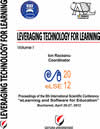WEB 3.0 in EDUCATION
WEB 3.0 in EDUCATION
Author(s): Ana-Maria Chisega-NegrilăSubject(s): Education
Published by: Carol I National Defence University Publishing House
Keywords: Semantic web; E-learning; knowledge; course design; education
Summary/Abstract: The emergence of Web 2.0 has marked a change in how the Internet users benefit from a number of tools that allow them to browse for information, exchange data, collaborate and interact with others. Web 2.0 has been a turning point in human interaction via computers, fostering social networks and even more personal environments for educational purposes such as PLEs or VLEs. Now, a leap forward is represented by Web 3.0, which should provide computers with the possibility to extract meaningful information from the Internet so that the inordinate number of data obtained after one search will be filtered, contrasted, and collated to better suit users’ needs. The advancement will consist in the fact that the search for information will not be just a sheer display of websites, chosen based on the key words entered, but meaningful information tagged with descriptors like mailing addresses. The implication for users are numerous as the new web search could function as a personal learning assistant and may help one reduce the amount of time spent looking for relevant data, be it educational or otherwise. Thus, the users interested in learning will be assisted by an agent, which will select the required information, and tailor it according to the individual learning needs. In this paper, the concept of Web 3.0 will be examined to find its possible educational uses and benefits. Moreover, the author will look into the impact of Web 3.0 on course design, on the one hand, and on the learners’ ability to identify and attend several courses provided by institutions, on the other hand.
Journal: Conference proceedings of »eLearning and Software for Education« (eLSE)
- Issue Year: 8/2012
- Issue No: 01
- Page Range: 455-460
- Page Count: 6
- Language: English

